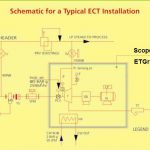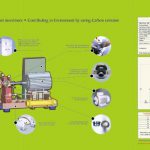Steam turbine cogeneration.
The Energy Conservation Turbine (ECT) will be used by any industry that currently uses a pressure reduction station (PRS) in their steam supply system. The ECT is installed in parallel with this PRS, to extract energy from the steam as it expands rather than simply throttle it as done by the PRS.
Most industries raise steam at a higher pressure than required by their plant equipment. The reason being the minimum pressure generally offered by boiler manufacturers is 10.5 bar or higher. By raising steam at a higher pressure, the size (and cost) of the steam lines between the boiler and process area, decreases drastically. At the process area, the steam pressure is throttled down and controlled accurately by a Pressure Reduction Station (PRS), which controls the down-stream process steam pressure. Normally this steam condenses in the process, transferring the latent heat of vaporization to the process. An ECT installed in parallel with the PRS utilizes the energy from the steam that is pressure reduced, to generate electrical power, which would have otherwise been lost in the form of noise and turbulence in the PRS.
What is ECT ?
ECT is a small cogeneration system catering to steam flow rates from 1.5 tons per hour and upwards. It is a backpressure steam Turbine used in parallel to an existing Pressure Reducing Valve (PRV) or PRDS. Steam is expanded in the back pressure turbine i.e. ECT, thus converting heat energy (of steam ) to electrical power. The Pressure control valve regulates the steam flow rate so as to maintain the required process steam pressure. Steam is used twice, first for power generation and secondly for process heating.
Who should use ECT ?
ECT is used by several process industries like Distilleries, Chemicals, Pharma, Paper, Food or any industry where there is a pressure reduction of steam through PRV/PRDS.
ECT being hermetically sealed, can also be employed in cases where there is pressure reduction of any gaseous stream such as nitrogen, methane, natural gas, etc.
Can ECT handle Saturated Steam ?
Yes! This is made possible by use of advanced technology and superior materials of construction i.e. hardened stainless steel for turbine, stainless for all steam wetted critical parts like turbine casing, nozzles, turning vanes, etc.
Can ECT handle variation in steam flow?
ET group appreciates the fact that the process is of prime importance and Power generation is only incidental or a by-product. The ECT design is flexible to allow the steam flow variation while keeping the process pressure constant.
How does one use the Electrical power? Does it need to be synchronized with existing power supply?
The turbine is coupled to an “Induction Generator” through a single stage speed reduction gearbox. The Induction Generator is a specially treated Induction motor running at super-synchronous speed. Therefore the induction generator does not need synchronizing with existing supply. This simplifies the electrical connectivity to any nearby Power control centre of adequate rating and capacities. Please refer to the advantages under technical data/control on an induction system.
If local circumstances require an A-synchronous or synchronous generator, it will be engineered with the turbine layout.
Control Philosophy and Operation of the Steam Turbine
ET Group Energy Conservation Turbine uses the grid excitation system for controlling the speed of the turbine. The unique feature is the steam assisted start system. The entire start sequence is programmed on the control panel and the operator has only to turn "ON" the key switch. This will automatically open the steam inlet valve to the turbine and once the induction generator attains a speed close to its motoring speed (this can be preset), the speed sensor will energize a contactor and bring on the Soft Starter. The steam flow through the turbine will within a few seconds take the machine to 'generating' mode.
The induction generator, connected to the grid, will automatically load share with the grid, thereby reducing the input from the grid, to the extent of the power generated by the turbine.
Practically no attention is required from the operator and the safety monitoring system in place will ensure 'fail safe' shut down of the turbine in the event of any undesirable operating condition.


![ect-system[2] ECT system](http://www.etgroup.nl/et/wp-content/uploads/2017/03/ect-system2-150x150.jpg)